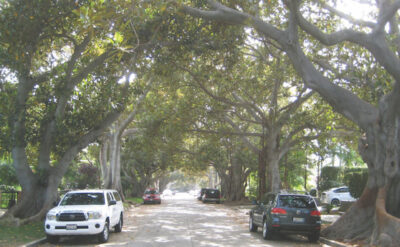Hot topic: keeping cool by greening our communities

ABUNDANT TREES on a Santa Monica street.
It’s not easy being green, but the hot topic was addressed by the nonprofit Westside Urban Forum (WUF) at a panel discussion on July 21 — “Private Trees, Public Benefit: Fortifying L.A.’s Disappearing Tree Canopy.” Panelists effectively made the case for keeping cool by greening our communities.
WUF regularly invites land use professionals to consider issues that affect our urban experience. The tree canopy, the “umbrella” function of a tree to shade the ground below, was addressed in this forum because it is a critical tool for climate regulation. In this age of unprecedented temperatures around the globe, adequate shade can lower the temperature of the ground by 20 degrees.
Those of us who live in Mid-Wilshire, one of the more verdant sectors of the City of Los Angeles, might not realize that great swaths of Los Angeles have lost as much as 55 percent of their tree cover — in the last ten years — due to rampant construction and the mansionization of our communities, replacing back yard trees with saleable square footage. Even Mayor Villaraigosa’s Million Trees initiative was a failed response to the need for trees. Many of those plantings died because there was inadequate infrastructure to support their care and maintenance.
So what can we do?
The five WUF panelists, who included developer Milan Ratkovich, a native of Windsor Square and Hancock Park, stressed that Los Angeles doesn’t place enough value on trees or have a master plan to guide tree work. One stated that we need to start thinking about it as infrastructure, “a green infrastructure that gains value over time, not just an expense.”
Another panelist said that we tend to think of trees as amenities, but in fact, “they are living partners.” Ratkovich pointed out that his company has found that its commercial clients value having outdoor green space.
Models around the globe
Panelists were quick to point to existing tree initiatives, in cities around the world, which can provide inspiration. Paris is in-filling its tree canopy, planting hundreds of trees along city boulevards and adding 200 new miles of bike paths. Barcelona has faced searing heat spikes, and city leaders have designated “superblocks” to become the green space “lungs” of the city. Barcelona also implemented Cool Walks, an app that guides pedestrians to the coolest-temperature walks based on time of day and where they’re going, even providing information on public water fountains and places to shelter from the heat.
Panelist and landscape architect Scott Baker, PLA, ASLA, explained that — closer to home and 25 years ago — Dallas utilized a maze of underground tunnels as a means of beating the heat. Subsequently, that city invested in a street plan of tree plantings and parks and turned itself into a pedestrian city. Said Baker: “If we want to be a flagship city, we need to lead!”
During the Zoom program, the panelists and attendees suggested other approaches, including: assessing a fee to home buyers who destroy trees during a renovation, with the funds received being used to plant trees elsewhere; working with developers to try to preserve existing mature trees on site; and offering creative ways to replace holes in the tree canopy.
Lower-income hot spots
When considering the best ways to add to our urban green space, panelists emphasized addressing the issue of inequities. By far the biggest hot spots are in lower-income neighborhoods, where parking lots flourish and existing street trees aren’t nurtured. Panelist Professor Eric Strauss from Loyola Marymount said that, in Los Angeles County, some of those underserved areas have as little as 2 percent tree canopy, compared to Pasadena, for example, which has 80 percent.
Panelist Wister Dorta, the urban forest supervisor for the City of Santa Monica, noted that residents of wealthier communities tend to ask the city for more trees, whereas those from poorer areas might not even know they are able to make that request. He added, “How do we ensure that neighborhoods that lack shade now are part of the decisions?”
Similar issues are addressed in Los Angeles by City Plants, and further information is available at cityplants.org.
Category: Real Estate
